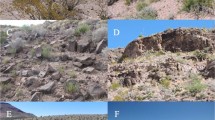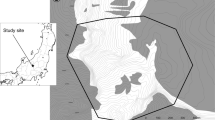Abstract
Previous research has shown that both ecological and social factors influence mountain gorilla habitat use. New data on habitat use by a male gorilla and by a group confirm that male mating competition influences short- and long-term habitat use patterns, and show that its influence can supersede that of ecological factors on a long-term basis. When solitary, the male regularly approached and sometimes followed groups. His monthly home range size and equitability of home range use were directly proportional to the number of such interactions per month. His relationships with other groups became more conservative after he gained females, and, contrary to expectations based on metabolic needs, he used a much smaller area. The group considered here gradually expanded its home range and shifted its areas of intensive use throughout a three-year period. It then made a complete home range shift after three dramatic interactions, during which it was temporarily fragmented and two females emigrated. The group shared its home range with many other social units; overlap with most of these decreased after the shift. The degree of overlap and the lack of site fidelity by males and their groups support the argument that transfer is not ecologically costly to mountain gorilla females.
Similar content being viewed by others
References
Barton, R. A., A. Whiten, S. C. Strum, R. W. Byrne, &A. J. Simpson, 1992. Habitat use and resource availability in baboons.Anim. Behav., 43: 831–844.
Bennett, E. L. &A. C. Sebastian, 1988. Social organization and ecology of proboscis monkeys (Nasalis larvatus) in mixed coastal forest in Sarawak.Int. J. Primatol., 9: 233–255.
Bradbury, J. W. &S. L. Vehrencamp, 1977. Social organization and foraging in emballonurid bats.Behav. Ecol. Sociobiol., 2: 1–17.
Caro, T. M., 1976. Observations on the ranging behavior and daily activity of a lone silverback mountain gorilla.Anim. Behav., 24: 889–897.
Casimir, M. J. &E. Butenandt, 1973. Migration and core area shifting in relation to ecological factors in a mountain gorilla group (Gorilla gorilla beringei) in the Mt. Kahuzi region (Republique du Zaire).Z. Tierpsychol., 33: 514–522.
Charles-Dominique, P., 1977.Ecology and Behavior of Nocturnal Prosimians. Columbia Univ. Press, New York.
Clutton-Brock, T. H. &P. H. Harvey, 1977. Primate ecology and social organization.J. Zool. London, 183: 1–39.
Dunbar, R. I. M., 1988.Primate Social Systems. Cornell Univ. Press, Ithaca.
Fossey, D., 1974. Observations on the home range of one group of mountain gorillas (Gorilla gorilla beringei).Anim. Behav., 22: 568–581.
———— &A. H. Harcourt, 1977. Feeding ecology of free-ranging mountain gorillas (Gorilla gorilla beringei). In:Primate Ecology,T. H. Clutton-Brock (ed.), Academic Press, New York, pp. 415–447.
Galdikas, B. M. F., 1979. Orangutan adaptation at Tanjung Puting Reserve: mating and ecology. In:The Great Apes,D. A. Hamburg &E. R. McCown (eds.), Benjamin/Cummings, Menlo Park, California, pp. 195–234.
Harcourt, A. H., 1978. Strategies of emigration and transfer by primates, with particular reference to gorillas.Z. Tierpsychol., 48: 401–420.
Harding, R. H. &D. K. Olsen, 1986. Patterns of mating among male patas monkeys (Erythrocebus patas) in Kenya.Amer. J. Primatol., 11: 343–358.
McFarland-Symington, M., 1988. Food competition and foraging party size in the black spider monkey (Ateles paniscus chantek).Behaviour, 105: 117–134.
Mitchell, C., S. Boinski, &C. P. van Schaik, 1991. Competitive regimes and social bonding in two species of squirrel monkeys (Saimiri oerstedi andSaimiri sciureus).Behav. Ecol. Sociobiol., 28: 55–60.
Newton, P. H., 1992. Feeding and ranging patterns of forest hanuman langurs (Presbytis entellus).Int. J. Primatol., 13: 245–286.
Pusey, A. E. &C. Packer, 1987. Dispersal and philopatry. In:Primate Societies,B. B. Smuts,D. L. Cheney,R. M. Seyfarth,R. W. Wrangham, &T. T. Struhsaker (eds.), Univ. of Chicago Press, Chicago, pp. 250–266.
Rajpurohit, L. S. &S. M. Mohnot, 1988. Fate of ousted residents of one-male bisexual troops of hanuman langurs (Presbytis entellus) at Jodhpur, Rajasthan, India.Human Evol., 3: 309–318.
Sicotte, P., in press. Inter-group encounters and female transfer in mountain gorillas: influence of group composition on male behavior.Amer. J. Primatology.
Stanford, C. B., 1991. Social dynamics of intergroup encounters in the capped langur (Presbytis pileatus).Amer. J. Primatol., 25: 35–47.
Stewart, K. J. &A. H. Harcourt, 1987. Gorillas: variation in female relationships. In:Primate Societies,B. B. Smuts,D. L. Cheney,R. M. Seyfarth,R. W. Wrangham, &T. T. Struhsaker (eds.), Univ. of Chicago Press, Chicago, pp. 155–164.
Struhsaker, T. T., 1975.The Red Colobus Monkey. Univ. of Chicago Press, Chicago.
Takasaki, H., 1981. Troop size habitat quality, and home range area in Japanese monkeys.Behav. Ecol. Sociobiol., 9: 277–281.
Terborgh, J., 1983.Five New World Primates. Princeton Univ. Press, Princeton.
Vedder, A. L., 1984. Movement patterns of a group of free-ranging mountain gorillas (Gorilla gorilla beringei) and their relation to food availability.Amer. J. Primatol., 7: 73–88.
Watts, D. P., 1983. Foraging strategy and socioecology of mountain gorillas. Unpubl. Ph.D. thesis, Univ. of Chicago, Chicago.
————, 1987. Effects of mountain gorilla foraging activities on the productivity of their food plant species.Afr. J. Ecol., 25: 155–163.
————, 1989. Infanticide in mountain gorillas: new cases and a reconsideration of the evidence.Ethology, 81: 1–18.
————, 1990. Ecology of gorillas and its relation to female transfer in mountain gorillas.Int. J. Primatol., 11: 21–45.
————, 1991. Habitat use strategies of mountain gorillas.Folia Primatol., 56: 1–16.
Weber, A. W. &A. L. Vedder, 1983. Population dynamics of the Virunga gorillas: 1959–1978.Biol. Conserv., 26: 341–366.
Whiten, A., R. W. Byrne, &S. P. Henzi, 1987. The behavioral ecology of mountain baboons.Int. J. Primatol., 8: 367–388.
Wrangham, R. W., 1979. On the evolution of ape social systems.Soc. Sci. Inform., 18: 334–368.
————, 1982. Mutualism, kinship, and social evolution. In:Current Problems in Sociobiology, King's College Sociobiology Group (eds.), Cambridge Univ. Press, Cambridge, pp. 269–289.
————, 1986. Ecology and social relationships in two species of chimpanzees. In:Ecological Aspects of Social Evolution,D. I. Rubenstein &R. W. Wrangham (eds.), Princeton Univ. Press, Princeton, pp. 352–378.
————, 1987. Evolution of social structure. In:Primate Societies,B. B. Smuts,D. L. Cheney,R. M. Seyfarth,R. W. Wrangham, &T. T. Struhsaker (eds.), Univ. of Chicago Press, Chicago, pp. 282–296.
Yamagiwa, J., 1986. Activity rhythm and the ranging of a solitary male mountain gorilla (Gorilla gorilla beringei).Primates, 27: 273–282.
————, 1987. Intra- and inter-group interactions of an all-male group of Virunga mountain gorillas (Gorilla gorilla beringei).Primates, 28: 1–30.
---- &Mwanza, in press. Day journey length and daily diet of solitary male gorillas in lowland and highland habitats.Int. J. Primatology.
Yeager, C. P., 1991. Proboscis monkey (Nasalis larvatus) social organization: intergroup patterns of association.Amer. J. Primatol., 23: 73–86.
Author information
Authors and Affiliations
About this article
Cite this article
Watts, D.P. The influence of male mating tactics on habitat use in mountain gorillas (Gorilla gorilla beringei). Primates 35, 35–47 (1994). https://doi.org/10.1007/BF02381484
Received:
Accepted:
Issue Date:
DOI: https://doi.org/10.1007/BF02381484




